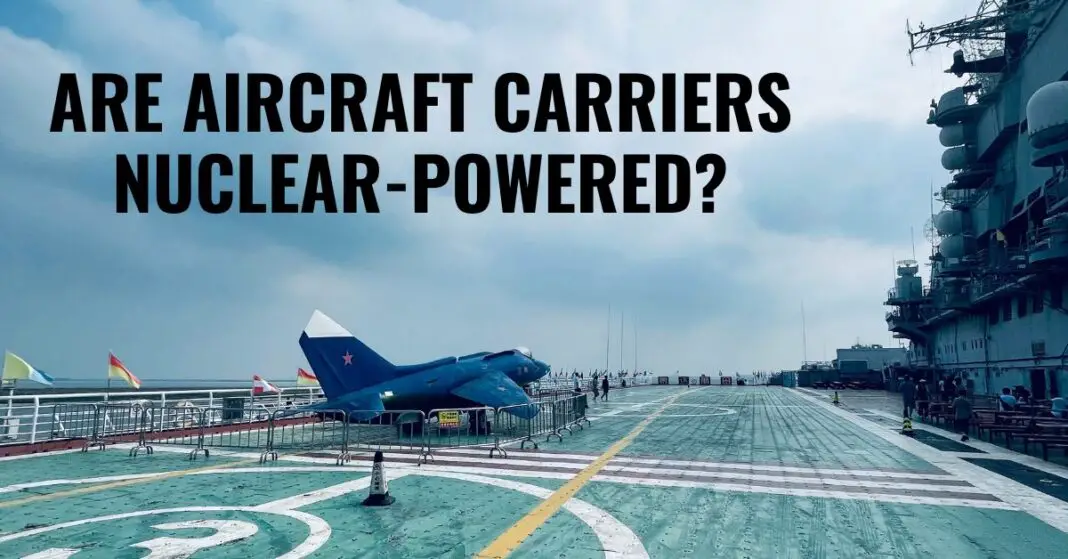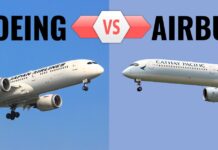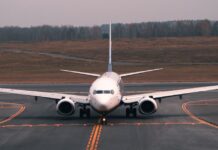Curious about the mighty vessels that rule the seas? In our exploration of aircraft carriers, we dive into a fundamental question: Are Aircraft Carriers Nuclear Powered?
Let’s break it down into simple terms, uncovering the propulsion systems that drive these colossal ships and the factors influencing the choices behind their power sources.
Table of Contents
The Proliferation of Nuclear-Powered Aircraft Carriers
It is critical to understand that the rise of nuclear-powered aircraft carriers reflects significant evolutions in both technological capabilities and strategic thinking in modern naval forces. On a basic level, these advancements are an intersection of advancements in nuclear technology and the strategic importance of establishing a naval presence across global waters.
In analyzing the technological side of the equation, one must acknowledge the exceptional efficiency of nuclear power. Traditional propulsion methods require vast amounts of fuel to operate, obligating the carrier to moor frequently for refueling, which interferes with strategic maneuverability.
The advent of nuclear technology, however, leveraged the fact that a small amount of nuclear fuel can generate immense power for long durations. Consequently, the use of this innovation has facilitated carriers that can circumnavigate the globe without requiring refueling for over 20 years. This is a significant factor that pays dividends in the strategic and operational freedom offered to naval fleets.
Simultaneously, the development of nuclear-powered aircraft carriers underscores the changing role of naval power in the geopolitical landscape. They form a critical reflection of the revolutionary concept of power projection– the capacity of a nation to apply all or some of its elements of national power – political, economic, informational, or military – from its home location to overseas directly and immediately.
These mobile seaborne airfields offer sovereign, unrestrained airpower at a global scale, in an increasingly interconnected world where rapid reaction times to regional crises have become imperative. The rise of nuclear-powered aircraft carriers is thus a telling tale of the constant endeavor to maintain a balance between technological progress and strategic readiness.
The Science Behind Nuclear-Powered Aircraft Carriers
Diving directly into the scientific principles responsible for the functioning of nuclear-powered aircraft carriers, it becomes clear that there are two main technologies at work: nuclear fission and steam turbine propulsion.
The nuclear reactors within these mighty vessels harness the energy produced by nuclear fission. When the uranium atoms’ nuclei, stocked in the reactor, are bombarded by neutrons, they fracture, giving off an enormous amount of heat. This process is self-sustaining after initiation since each shattered atom releases additional neutrons that go on to split more atoms. This ‘chain reaction’ is nurtured precisely, ensuring consistent heat levels in the reactor’s core.
The copious heat produced from this nuclear fission doesn’t push the ship forward directly. Instead, it is used to convert water into high-pressure steam, adhering to the earlier-identified principle of steam turbine propulsion. The steam generated pushes against the blades of a turbine, converting thermal energy to mechanical energy as the turbine spins.
This rotational movement is transferred to the ship’s propellers via shafts, propelling the vessel forward. It is crucial to note that a nuclear-powered steam turbine operates similarly to a conventional fossil fuel turbine, with the only difference being the heat source. Additionally, steam is also used for various other onboard operations, such as catapulting aircraft off the deck.
The extraordinary energy density of nuclear power enables these carriers to operate continuously for decades before refueling. This, in turn, allows long-haul global missions, reinforcing the country’s task force availability and thus, its military potency. Still, although nuclear technology has immense advantages, it requires scrupulous attention to safety protocols and environmental concerns.
The nuclear-powered aircraft carriers, in their grandiosity of power, science, and strategic importance, undeniably reflect humanity’s ongoing quest for technological advancement in the face of evolving global challenges.
The Advantages and Disadvantages of Nuclear-Powered Aircraft Carriers
Nuclear-powered aircraft carriers undoubtedly carry an array of benefits, yet they are also accompanied by notable obstacles and concerns that can potentially influence naval strategy.
One significant advantage of these carriers is their substantial propulsion endurance. Designed to operate uninterruptedly for up to two decades, nuclear-powered carriers supersede their conventional counterparts by eliminating the necessity for periodic refueling. This commendable energy efficiency permits extended deployments, thus enhancing the military’s operational flexibility.
Moreover, the lack of fuel storage enhances these carriers’ ability to carry additional aircraft, munitions, and provisions, further increasing their operational efficacy.
However, these pertinent advantages accompany considerable impediments. For one, the high costs associated with building, operating, and appropriately disposing of spent nuclear fuel and decommissioned carriers constitute a significant disincentive.
Furthermore, the risk of nuclear accidents, though minimized by rigorous safety protocols, is invariably attendant to these carriers, potentially engendering substantial humanitarian and ecological ramifications.
Nuclear technology has heralded a new era for military strategy, particularly concerning aircraft carriers. As the origin of their propulsion shifts from fossil fuels to atoms, aircraft carriers’ strategic applications have expanded, fundamentally transfiguring maritime warfare.
However, the ecological and financial costs inherent in the adoption of nuclear power necessitate pragmatism in this pursuit. As technological advancements continue to unfold, it remains essential to weigh these benefits and drawbacks judiciously for the most beneficial and responsible application of nuclear technology in naval strategy.
The Future of Nuclear-Powered Aircraft Carriers
As we look forward to the future of nuclear-powered aircraft carriers, continued research and innovation will drive the evolution of this technology. More efficient, compact nuclear reactors are on the horizon, promising to reduce ship weight and potentially increase carrier speed and agility.
The advent of these advanced reactors will also allow for more space on board for additional aircraft and weaponry, further augmenting their military reach and capabilities.
In the realm of technology, digitization, and artificial intelligence are poised to play a pivotal role in managing these complex naval platforms. Automation and robotics technologies could reduce the number of personnel needed on board, lowering operational costs and further increasing the efficiencies of these vessels.
Equally, high-tech defense systems such as advanced missile defense and laser technology will bolster the protective capabilities of these carriers, adding a layer of safety in an increasingly high-tech theatre of war.
Environmental sustainability will also shape the future of these massive warships. Despite originating from a non-renewable source, nuclear power substantially reduces a carrier’s carbon footprint compared to conventional propulsion methods. However, the disposal of spent nuclear fuel and decommissioned carriers remains a contentious issue.
Thankfully, advancements in nuclear waste management and recycling techniques are helping to tackle these concerns, addressing the ecological impact and enabling a more responsible utilization of nuclear technology.
Ultimately, it is the amalgamation of technological innovations, prudent leadership, and policy decisions, that will shape the future of nuclear-powered aircraft carriers.
Undoubtedly, they will continue to serve as a symbol of a nation’s naval supremacy and technical prowess, while their evolution will reflect the ongoing commitment to advancing scientific knowledge, mastering technology and carefully navigating the myriad of geopolitical, economic, and environmental considerations.
How many aircraft carriers are nuclear-powered?
Currently, the global fleet of operational nuclear-powered aircraft carriers stands at 12. The United States leads with 11 carriers, consisting of 10 Nimitz-class vessels and one Gerald R. Ford-class ship. France contributes to this elite group with its single nuclear-powered aircraft carrier, the Charles de Gaulle.
Are US aircraft carriers nuclear powered?
Yes, all US aircraft carriers are nuclear-powered. As of today, the US Navy has a total of 11 actively deployed nuclear-powered aircraft carriers.
Why are UK aircraft carriers not nuclear?
The UK’s decision not to equip its Queen Elizabeth-class aircraft carriers with nuclear propulsion boils down to cost considerations, as nuclear systems are more expensive than the current conventional setup. Manpower shortages, political restrictions on nuclear vessels in some waters, and technical challenges in integrating reactors into large warships further influenced this choice.
Why doesn’t China have nuclear powered aircraft carriers?
China currently opts for non-nuclear aircraft carriers due to technical challenges in adapting land-based nuclear technology for naval use, the cost and complexity associated with nuclear-powered carriers, and strategic considerations favoring smaller, more agile designs.
International pressure, driven by concerns about military expansion and nuclear proliferation, also contributes to China’s decision against developing nuclear-powered carriers.





